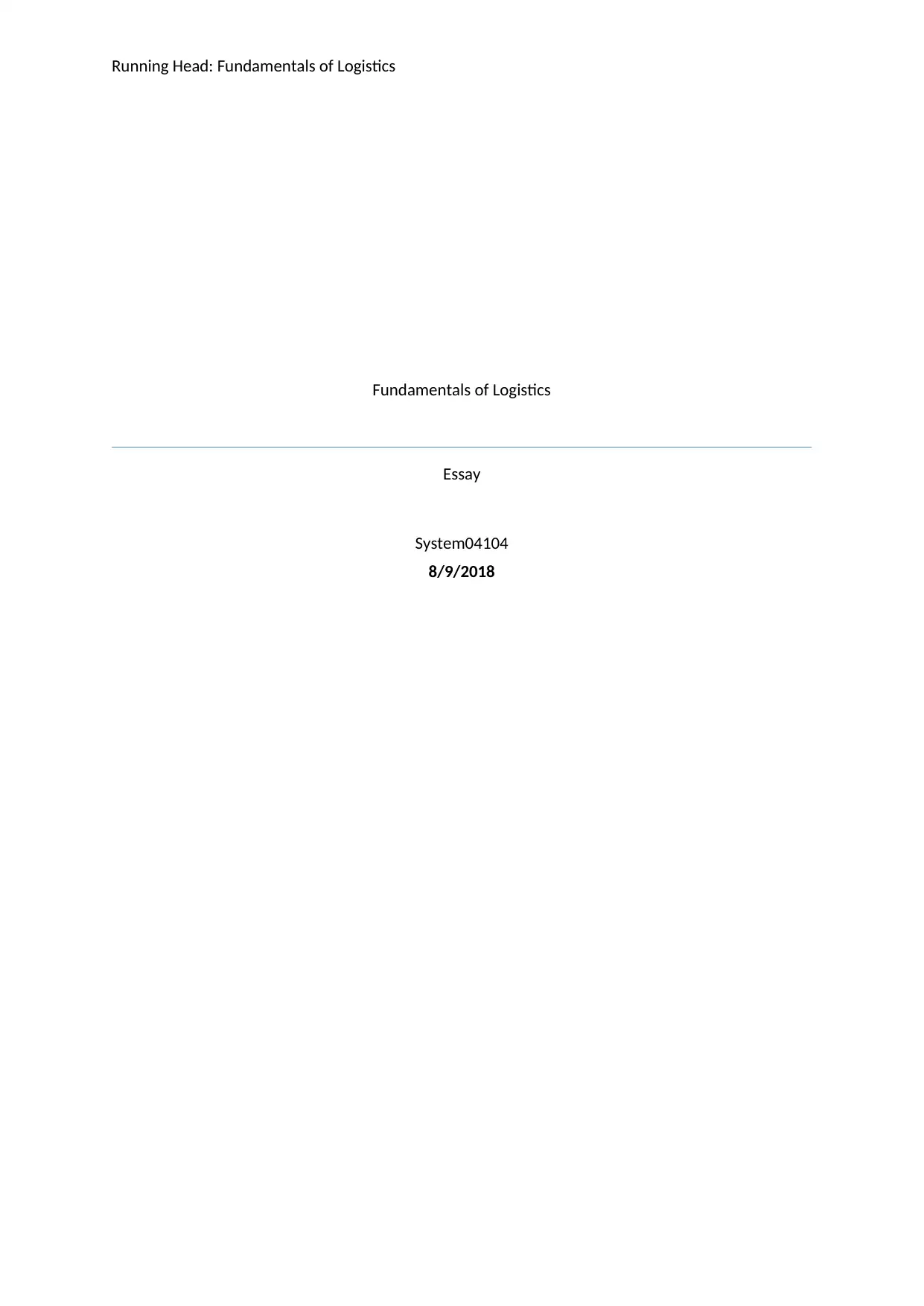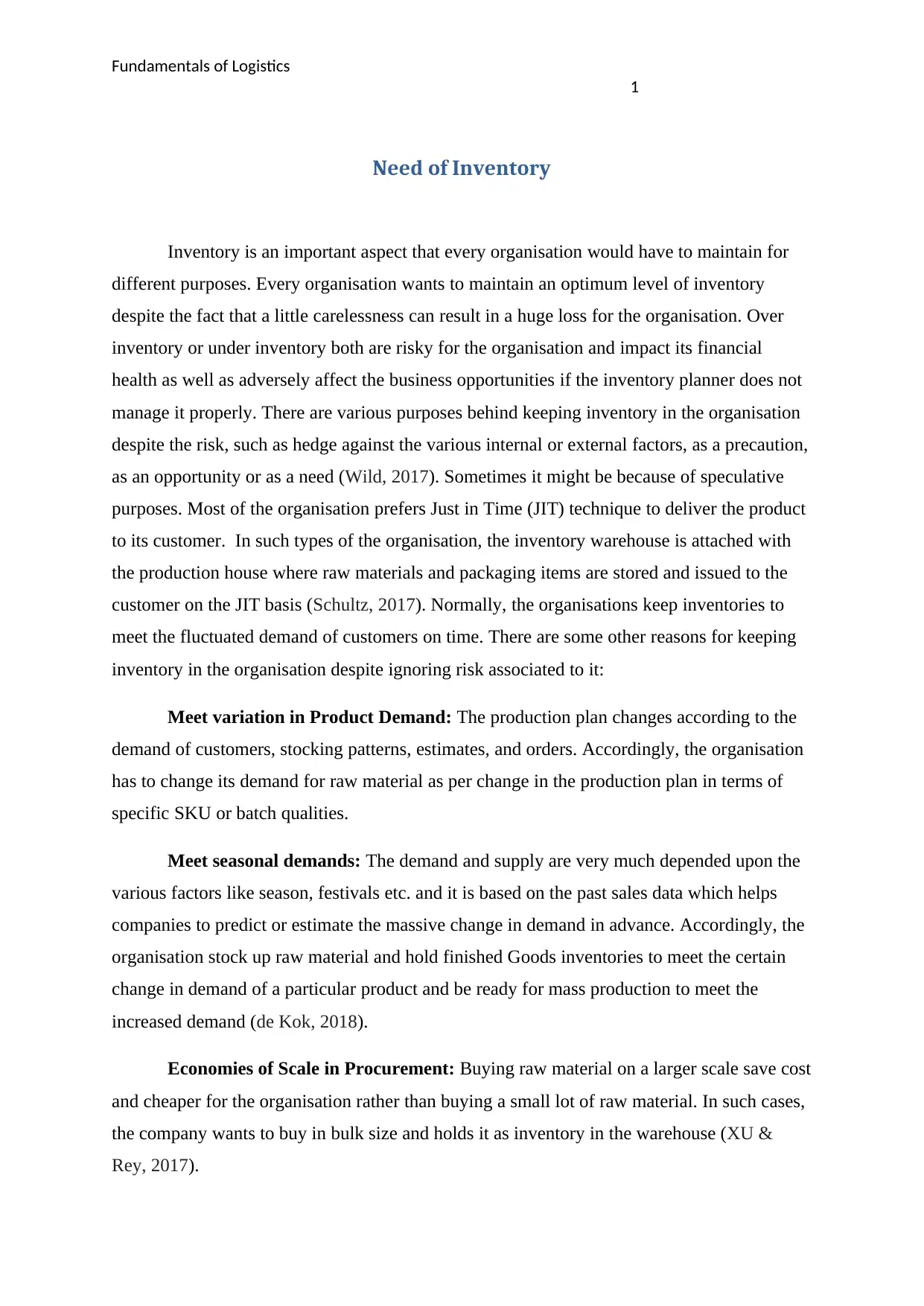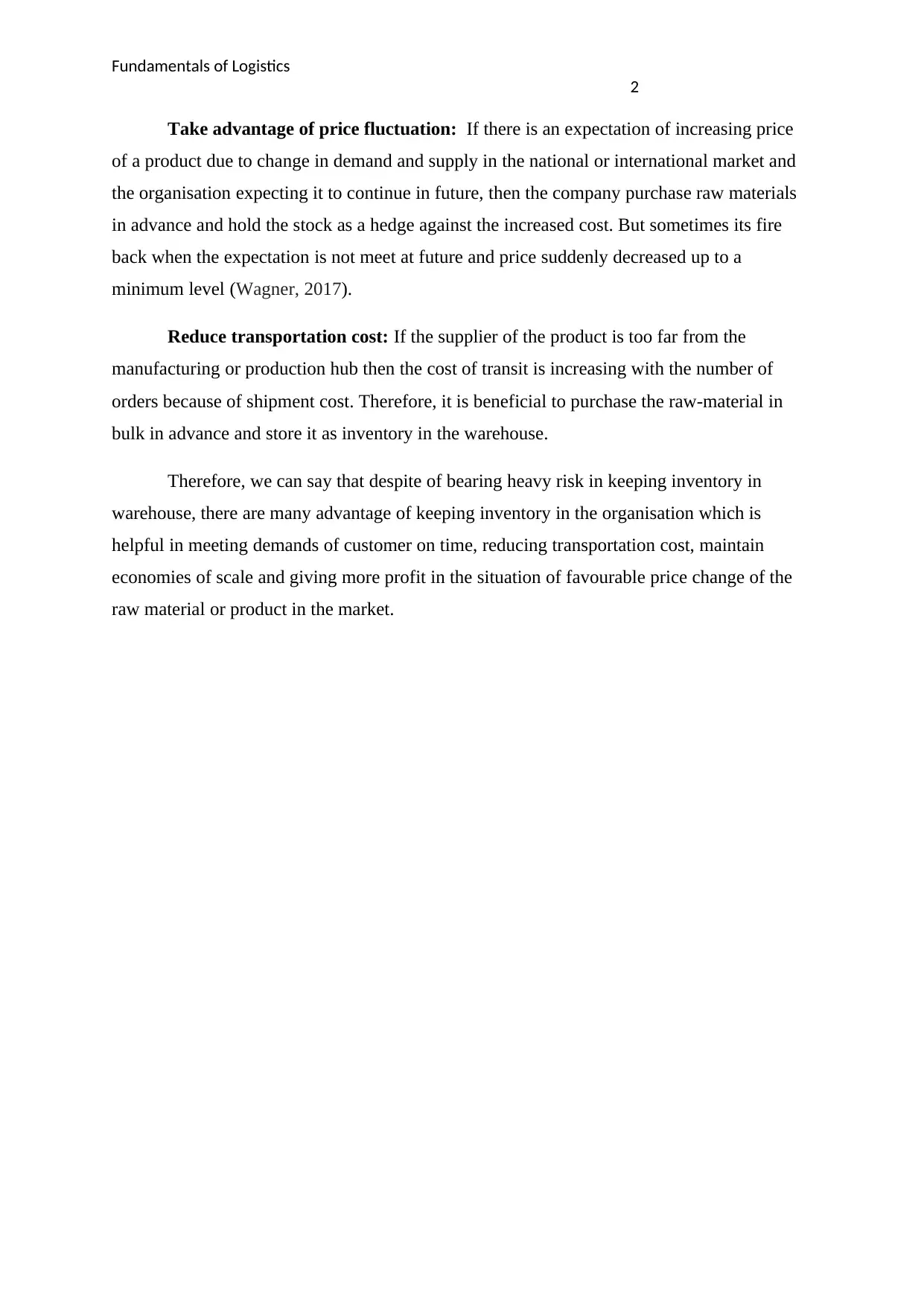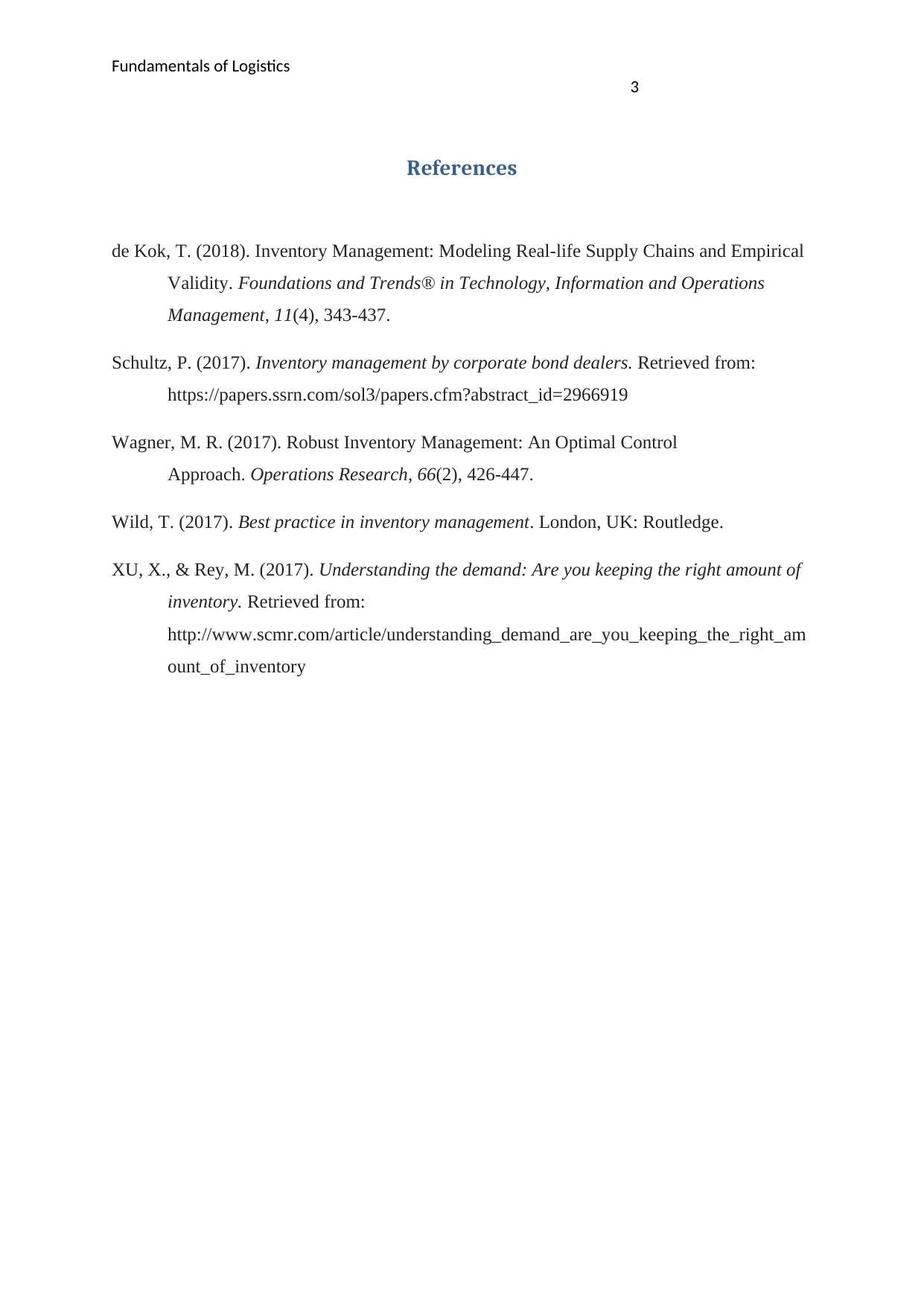Essay on the Fundamentals of Logistics and Inventory Management
VerifiedAdded on 2023/06/08
|4
|798
|218
Essay
AI Summary
This essay explores the fundamentals of logistics, emphasizing the critical role of inventory management within organizations. It discusses the various reasons why companies maintain inventory, including meeting fluctuating product demands, accommodating seasonal variations, achieving economies of scale in procurement, leveraging price fluctuations, and reducing transportation costs. The essay highlights that while inventory management carries inherent risks, its advantages, such as ensuring timely customer service and optimizing costs, make it an indispensable component of effective logistical operations. The document is available on Desklib, a platform offering a wide range of study tools for students.

Running Head: Fundamentals of Logistics
Fundamentals of Logistics
Essay
System04104
8/9/2018
Fundamentals of Logistics
Essay
System04104
8/9/2018
Paraphrase This Document
Need a fresh take? Get an instant paraphrase of this document with our AI Paraphraser

Fundamentals of Logistics
1
Need of Inventory
Inventory is an important aspect that every organisation would have to maintain for
different purposes. Every organisation wants to maintain an optimum level of inventory
despite the fact that a little carelessness can result in a huge loss for the organisation. Over
inventory or under inventory both are risky for the organisation and impact its financial
health as well as adversely affect the business opportunities if the inventory planner does not
manage it properly. There are various purposes behind keeping inventory in the organisation
despite the risk, such as hedge against the various internal or external factors, as a precaution,
as an opportunity or as a need (Wild, 2017). Sometimes it might be because of speculative
purposes. Most of the organisation prefers Just in Time (JIT) technique to deliver the product
to its customer. In such types of the organisation, the inventory warehouse is attached with
the production house where raw materials and packaging items are stored and issued to the
customer on the JIT basis (Schultz, 2017). Normally, the organisations keep inventories to
meet the fluctuated demand of customers on time. There are some other reasons for keeping
inventory in the organisation despite ignoring risk associated to it:
Meet variation in Product Demand: The production plan changes according to the
demand of customers, stocking patterns, estimates, and orders. Accordingly, the organisation
has to change its demand for raw material as per change in the production plan in terms of
specific SKU or batch qualities.
Meet seasonal demands: The demand and supply are very much depended upon the
various factors like season, festivals etc. and it is based on the past sales data which helps
companies to predict or estimate the massive change in demand in advance. Accordingly, the
organisation stock up raw material and hold finished Goods inventories to meet the certain
change in demand of a particular product and be ready for mass production to meet the
increased demand (de Kok, 2018).
Economies of Scale in Procurement: Buying raw material on a larger scale save cost
and cheaper for the organisation rather than buying a small lot of raw material. In such cases,
the company wants to buy in bulk size and holds it as inventory in the warehouse (XU &
Rey, 2017).
1
Need of Inventory
Inventory is an important aspect that every organisation would have to maintain for
different purposes. Every organisation wants to maintain an optimum level of inventory
despite the fact that a little carelessness can result in a huge loss for the organisation. Over
inventory or under inventory both are risky for the organisation and impact its financial
health as well as adversely affect the business opportunities if the inventory planner does not
manage it properly. There are various purposes behind keeping inventory in the organisation
despite the risk, such as hedge against the various internal or external factors, as a precaution,
as an opportunity or as a need (Wild, 2017). Sometimes it might be because of speculative
purposes. Most of the organisation prefers Just in Time (JIT) technique to deliver the product
to its customer. In such types of the organisation, the inventory warehouse is attached with
the production house where raw materials and packaging items are stored and issued to the
customer on the JIT basis (Schultz, 2017). Normally, the organisations keep inventories to
meet the fluctuated demand of customers on time. There are some other reasons for keeping
inventory in the organisation despite ignoring risk associated to it:
Meet variation in Product Demand: The production plan changes according to the
demand of customers, stocking patterns, estimates, and orders. Accordingly, the organisation
has to change its demand for raw material as per change in the production plan in terms of
specific SKU or batch qualities.
Meet seasonal demands: The demand and supply are very much depended upon the
various factors like season, festivals etc. and it is based on the past sales data which helps
companies to predict or estimate the massive change in demand in advance. Accordingly, the
organisation stock up raw material and hold finished Goods inventories to meet the certain
change in demand of a particular product and be ready for mass production to meet the
increased demand (de Kok, 2018).
Economies of Scale in Procurement: Buying raw material on a larger scale save cost
and cheaper for the organisation rather than buying a small lot of raw material. In such cases,
the company wants to buy in bulk size and holds it as inventory in the warehouse (XU &
Rey, 2017).

Fundamentals of Logistics
2
Take advantage of price fluctuation: If there is an expectation of increasing price
of a product due to change in demand and supply in the national or international market and
the organisation expecting it to continue in future, then the company purchase raw materials
in advance and hold the stock as a hedge against the increased cost. But sometimes its fire
back when the expectation is not meet at future and price suddenly decreased up to a
minimum level (Wagner, 2017).
Reduce transportation cost: If the supplier of the product is too far from the
manufacturing or production hub then the cost of transit is increasing with the number of
orders because of shipment cost. Therefore, it is beneficial to purchase the raw-material in
bulk in advance and store it as inventory in the warehouse.
Therefore, we can say that despite of bearing heavy risk in keeping inventory in
warehouse, there are many advantage of keeping inventory in the organisation which is
helpful in meeting demands of customer on time, reducing transportation cost, maintain
economies of scale and giving more profit in the situation of favourable price change of the
raw material or product in the market.
2
Take advantage of price fluctuation: If there is an expectation of increasing price
of a product due to change in demand and supply in the national or international market and
the organisation expecting it to continue in future, then the company purchase raw materials
in advance and hold the stock as a hedge against the increased cost. But sometimes its fire
back when the expectation is not meet at future and price suddenly decreased up to a
minimum level (Wagner, 2017).
Reduce transportation cost: If the supplier of the product is too far from the
manufacturing or production hub then the cost of transit is increasing with the number of
orders because of shipment cost. Therefore, it is beneficial to purchase the raw-material in
bulk in advance and store it as inventory in the warehouse.
Therefore, we can say that despite of bearing heavy risk in keeping inventory in
warehouse, there are many advantage of keeping inventory in the organisation which is
helpful in meeting demands of customer on time, reducing transportation cost, maintain
economies of scale and giving more profit in the situation of favourable price change of the
raw material or product in the market.
⊘ This is a preview!⊘
Do you want full access?
Subscribe today to unlock all pages.

Trusted by 1+ million students worldwide

Fundamentals of Logistics
3
References
de Kok, T. (2018). Inventory Management: Modeling Real-life Supply Chains and Empirical
Validity. Foundations and Trends® in Technology, Information and Operations
Management, 11(4), 343-437.
Schultz, P. (2017). Inventory management by corporate bond dealers. Retrieved from:
https://papers.ssrn.com/sol3/papers.cfm?abstract_id=2966919
Wagner, M. R. (2017). Robust Inventory Management: An Optimal Control
Approach. Operations Research, 66(2), 426-447.
Wild, T. (2017). Best practice in inventory management. London, UK: Routledge.
XU, X., & Rey, M. (2017). Understanding the demand: Are you keeping the right amount of
inventory. Retrieved from:
http://www.scmr.com/article/understanding_demand_are_you_keeping_the_right_am
ount_of_inventory
3
References
de Kok, T. (2018). Inventory Management: Modeling Real-life Supply Chains and Empirical
Validity. Foundations and Trends® in Technology, Information and Operations
Management, 11(4), 343-437.
Schultz, P. (2017). Inventory management by corporate bond dealers. Retrieved from:
https://papers.ssrn.com/sol3/papers.cfm?abstract_id=2966919
Wagner, M. R. (2017). Robust Inventory Management: An Optimal Control
Approach. Operations Research, 66(2), 426-447.
Wild, T. (2017). Best practice in inventory management. London, UK: Routledge.
XU, X., & Rey, M. (2017). Understanding the demand: Are you keeping the right amount of
inventory. Retrieved from:
http://www.scmr.com/article/understanding_demand_are_you_keeping_the_right_am
ount_of_inventory
1 out of 4
Related Documents
Your All-in-One AI-Powered Toolkit for Academic Success.
+13062052269
info@desklib.com
Available 24*7 on WhatsApp / Email
![[object Object]](/_next/static/media/star-bottom.7253800d.svg)
Unlock your academic potential
Copyright © 2020–2025 A2Z Services. All Rights Reserved. Developed and managed by ZUCOL.





